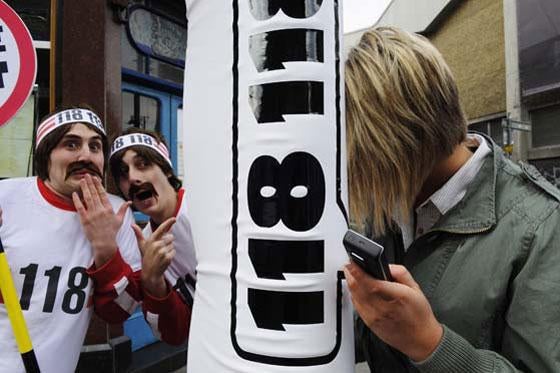
A story claiming that lampposts in an East London street had been fitted with pads to protect text-messaging pedestrians – covered across UK and foreign media – led journalists to ‘suspend their disbelief”, it was claimed this week.
Journalists across the world reported that Britain’s first ‘safe text’street had been created via the creation of a pilot scheme which could be extended across the country.
But locals in Tower Hamlets have said that the padding – put in place by a PR firm working for directory company 118118 – were only on a few lampposts and only there for a day and a half.
Data from a study of more than 1,000 people for 118118 and charity Living Streets was used to claim that 6.5 million people in Britain were injured while sending messages in the last year.
And in separate research – based on the number of complaints the charity had received in the past year – Brick Lane was labelled as the most dangerous street in the country for texting.
The phone directory company said in a press release, written by PR firm Resonate, that ‘safe text’rubber pads, similar to ones used on rugby posts, were being put on lampposts in the street to minimise harm. It claimed the ‘trailblazing’scheme would be monitored before it was decided whether to expand it to other parts of the country.
‘Safe text’
The story was covered in papers including The Guardian, Evening Standard, Daily Mail, Daily Star, Daily Express, Daily Mirror and in newspapers as far away as New Zealand, Australia and the USA.
The Daily Mail said: ‘Britain’s first safe text street has been created – complete with padded lampposts – to protect millions of mobile phone users from getting hurt in street accidents while walking and texting.”
Architect’s Journal said: ‘Landscape architects take note. The lampposts of Brick Lane in London’s trendy Hoxton have been padded after the street was branded an ‘accident blackspot’ for drunken skinny-jeaned texters.”
The East London Advertiser quoted one Brick Lane trader, who said that the pads were taken down after five minutes. Tower Hamlets Council said it was unaware of the scheme and that it had ‘nothing to do’with the council.
East London Advertiser editor Malcolm Starbrook said: ‘In general the media coverage was a suspension of disbelief. They wanted the story to be correct and they never went into it. To be fair, 118118 is an accredited business and it did say the research was being done with a reputable charity and in many ways it was a story that hung together.
‘It was putting the cushions up, taking photographs and then taking them down. What kind of research pooled of 1,000 people is going to be able to identify one street in East London?”
TNS Global Research spoke to 1,055 people and found that one in 10 had suffered an injury. Using this figure, it therefore asserted that ‘up to 6,647,354 innocent pedestrians’– the equivalent of 10 per cent of the population – were injured in the past year.
A spokesman for 118118 said: ‘The important thing it is that it is a pilot scheme and the goal was to test out and gauge people’s opinions. We’ve raised a lot of debate around it and that was what we were trying to achieve.
‘I personally don’t think we misled anyone – there have been various complaints on the Living Streets website about Brick Lane and if you go there it is probably the most cluttered street in Britain.”
Email pged@pressgazette.co.uk to point out mistakes, provide story tips or send in a letter for publication on our "Letters Page" blog
